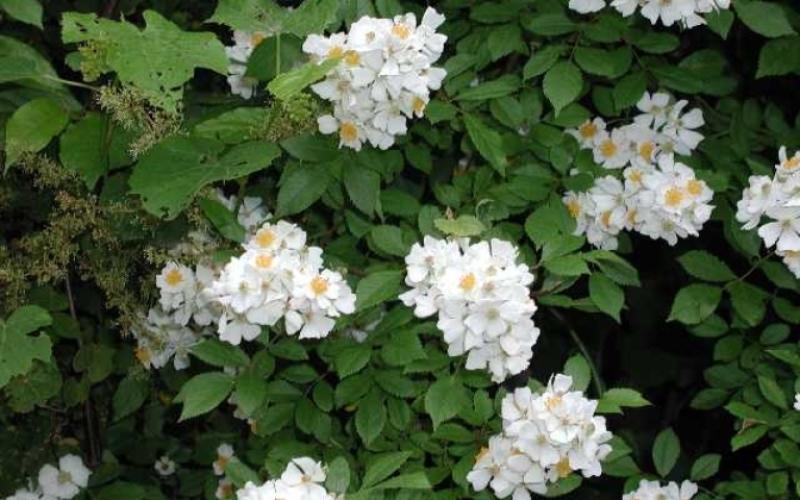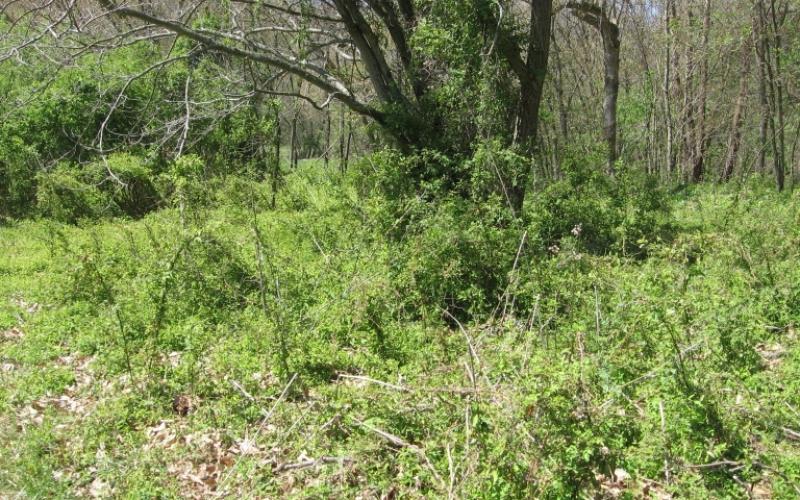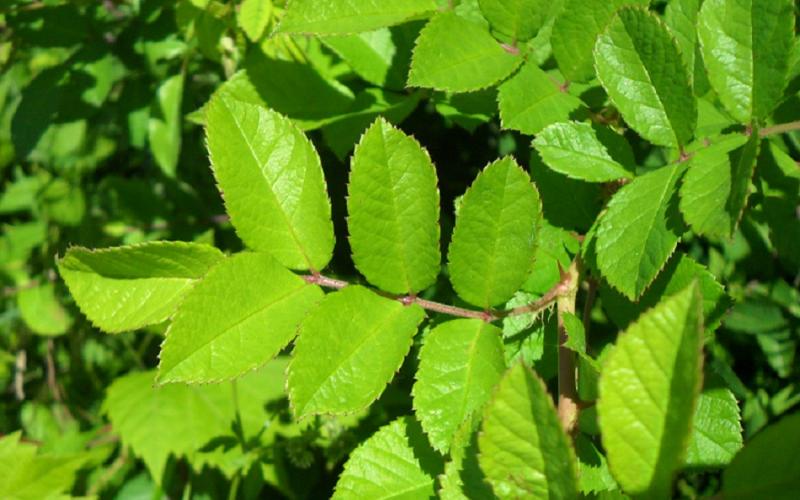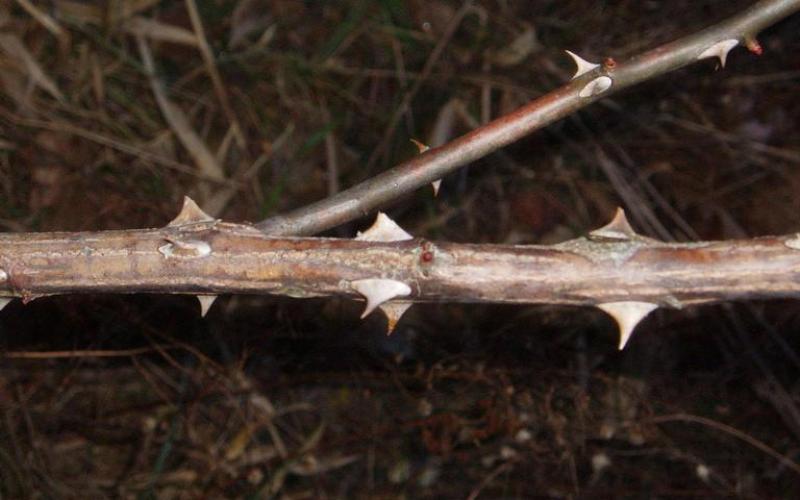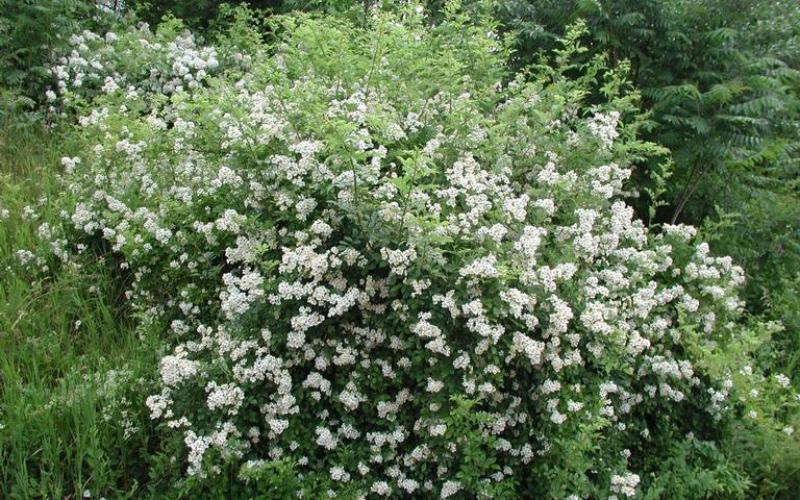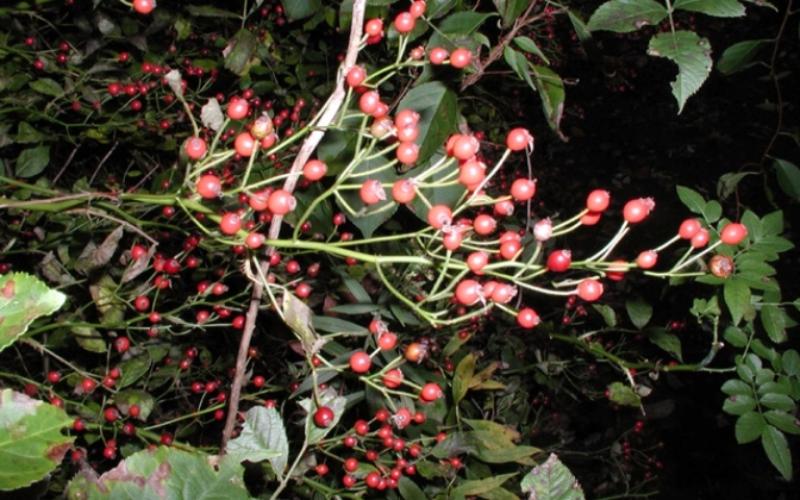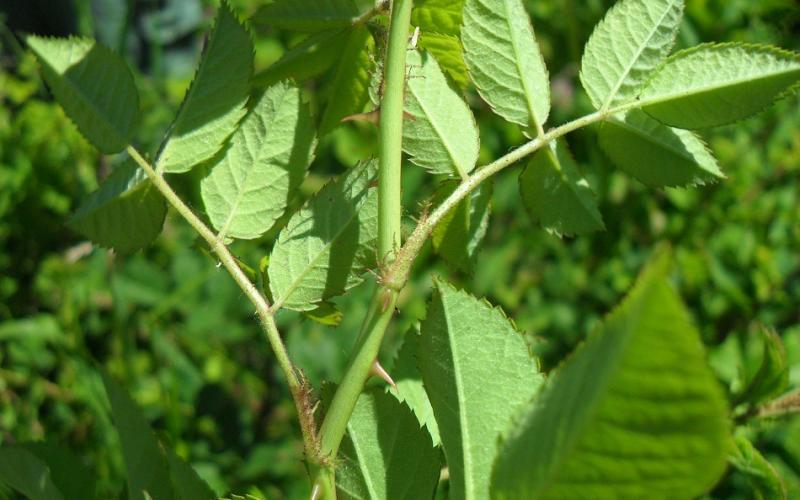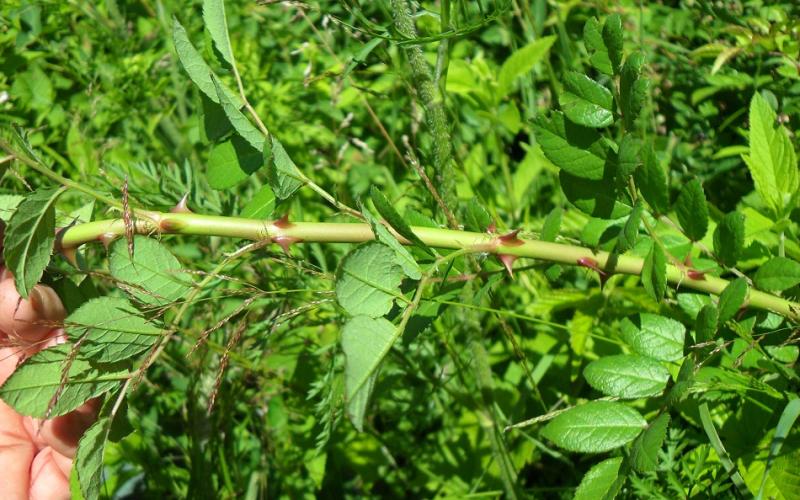Common Name: Multiflora Rose
Alternate Names: Japanese rose, seven-sisters rose, rambler rose, multiflowered rose
Scientific Name: Rosa multiflora Thunb.
Legal Status
Propagation and sale of this plant are prohibited in Minnesota. Transportation is only allowed when in compliance with Minnesota Statute 18.82. Although Restricted Noxious Weeds are not required to be controlled or eradicated by law, landowners are strongly encouraged to manage these invasive plants on their properties in order to reduce spread into new areas.
Background
Multiflora rose, native to eastern Asia, is a highly invasive perennial shrub that can reach heights of 4- 15 feet. This species was introduced to North America as a rootstock for ornamental roses and also used for erosion control, living fence rows and wildlife habitat. Since its introduction, it has spread aggressively across most of the eastern half of the United States and has become a serious threat to the degradation of a variety of riparian, upland and forest habitats where it outcompetes native plant species.
Description
- A multi-stemmed, bushy shrub with long, arching, thorny stems (canes) that form dense impenetrable thickets. The first 4- 5 feet of the stems are erect and the young, top growth arches back to the ground, which can then root. Most plants grow vertically 4- 6 feet in height, but individual arching stems may reach horizontal lengths of up to 15 feet.
- Stems are long, flexible, arching, and green or reddish in color. Stiff, backward-curved thorns with wide bases and sharp narrow points extend along the length of the stems.
- Leaves are alternate, pinnately compound and divided into 5- 11 leaflets. Leaflets are 1- 2 inches in length, with pale undersides, finely toothed, and have a characteristic fringed/bristly stipule at the base of each leaf stalk.
- Flowering stalks produce clusters of showy white (sometimes slightly pink) 5-petaled flowers that bloom in May and June and have a distinct rose fragrance. Flowers are also characterized by having a ring of abundant stamens with yellow anthers, notched petals, and being 1- 2 inches in diameter.
- Fertile flowers eventually produce small "leathery" rose hips that turn bright red or orange-red with maturity. Each rose hip contains several seeds and can remain on the plant throughout the winter.
Habitat
Multiflora rose is typically found in forest understories and clearings, hedgerows, savannas, stream banks, wetland and bog edges, pastures, abandoned fields, urban woodlots, roadsides, and other disturbed habitats. This species is commonly found throughout the southeastern counties of the state and has continued to slowly spread northward into the Twin Cities metro area and beyond. Landowners and managers should be aware of this species and eradicate newly discovered populations to avoid spread into valuable forest lands and other sensitive habitats.
Means of spread and distribution
The primary means of spread are by seed dispersal and the rooting of arching stems. Rose hips will fall near the parent plant. Birds and small mammals will also consume them and spread seeds to new areas. Due to the spread of seeds via birds, multiflora rose is difficult to control and eradicate. Plant stems can also arch back to the ground and root, causing existing populations to spread outward in this manner, creating dense impenetrable thickets.
Impacts
Multiflora rose grows and spreads aggressively by producing high numbers of viable seeds that are consumed by birds or small mammals and distributed to new areas. It also has the ability to spread when arching stems (canes) touch the ground and root. The thorny, ridged stems tangle around one another and vine around smaller trees and shrubs to create impenetrable thickets that are extremely hard for humans and livestock to navigate through. Its vigorous growth and rapid spread outcompetes native vegetation and inhibits the development of native trees, shrubs, grasses, and forbs in forests, uplands, pastures, savannas, and forest clearings.
Prevention and Management
- A sound management plan is necessary to manage this species and will take a commitment of several years to ensure that the population has been eliminated or is at least under control. Landowners that work together with their adjacent neighbors and local governments to develop a long-term regional management plan have the greatest success in reducing this species over time. Management plans that emphasize native species restoration following treatments have been shown to sustain management well into the future and prevent new populations from developing. New infestations are less costly to control and easier to eradicate. Once multiflora rose becomes well-established on a property, it can be expensive to control and requires a significant amount of labor. Landowners that live adjacent to or near established multiflora rose populations should continually be on the look-out to eradicate seedlings and small plants invading their properties.
- Large populations that are found in or along pasture areas, savanna habitats, or other upland sites can be mowed or cut 3- 6 times per growing season for a period of 2- 4 years. When dealing with smaller infestations, individual plants can be pulled with a root extraction tool or by using a chain to pull from the ground using a tractor or off-road vehicle. Because stems have the ability to re-root, pulled plants should be gathered and burned or piled at a designated site to monitor over time. The thorns on this species are impressive and sharp. Always wear protective clothing when working with this plant.
- Early-spring controlled burns, in fire-adapted natural areas, can be a useful approach to controlling multiflora rose in large forests, pastures, uplands, and smaller woodlots with dense populations. Burning every year or every other year on well-established stands may be necessary to significantly reduce multiflora rose density and regeneration. Fire is not a stand-alone management option and usually works best in conjunction with herbicide applications and mechanical strategies. Make sure to contact the Minnesota Department of Natural Resources to learn more about control burning practices and regulations.
- Multiflora rose can be successfully controlled in a variety of habitats by grazing goats and sheep. Goats are hardier when it comes to multiflora rose than sheep and they are not deterred by the thorny stems. There are many examples of using goats successfully for weed control in pastures, rangelands, and forested landscapes. In pasture situations, research at West Virginia University has shown that an initial stocking rate of 8 to 10 mature goats and/or sheep be used per acre for up to four seasons. Stocking rates should be reduced later in the season when pasture growth slows.
- Foliar, basal bark and cut-stem application of herbicides that translocate their active ingredients into the root system can be very effective. Foliar treatments work best on seedlings and larger plants during the growing season. Basal bark and cut-stem treatments work better on mature plants and can be applied during the late fall when other forest understory plants have gone dormant. Treatments will need to be administered for several growing seasons until the population is eliminated or under control. If using herbicide treatments, check with your local University of Minnesota Extension agent, co-op, or certified landscape care expert for assistance and recommendations. There are several businesses throughout the state with certified herbicide applicators that can be hired to perform chemical applications. Multiflora rose is also found in or around riparian and wetland habitats. If treating plants near water with an herbicide, please be aware of the state pesticide laws and use only products labeled for aquatic use.
- Multiflora rose lifecycle and treatment timing graphic
